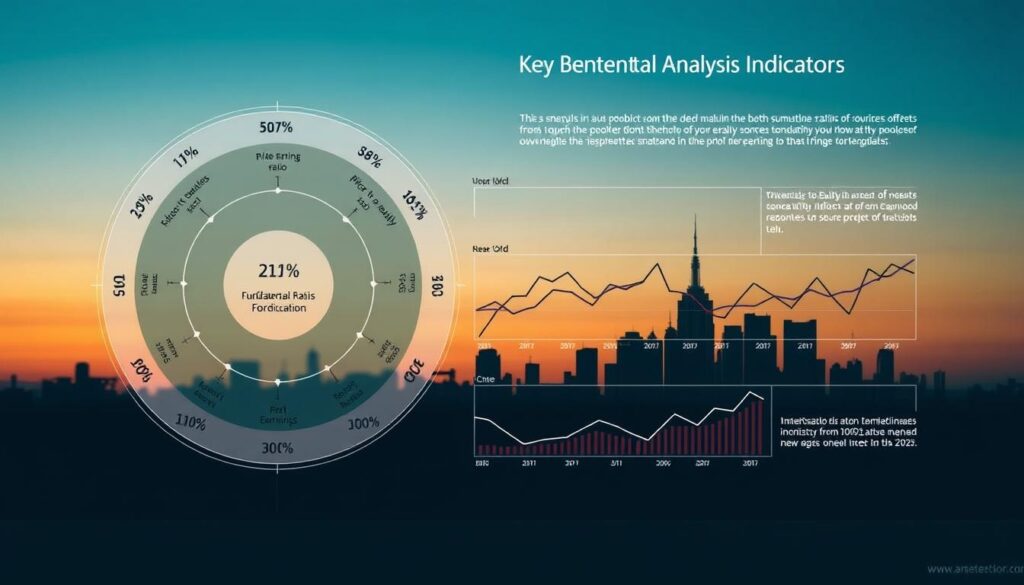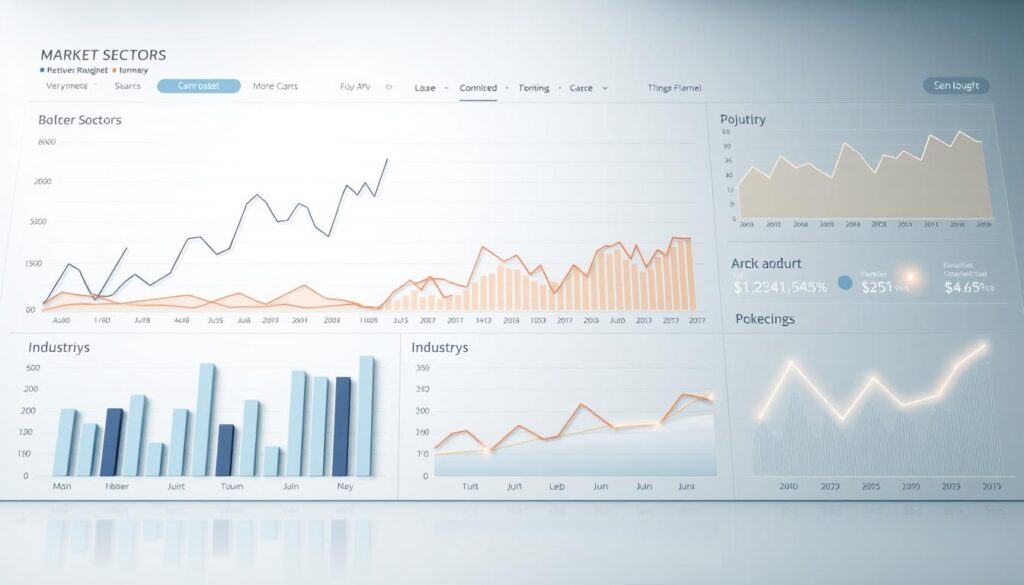Understanding the health of the stock market is crucial for making informed investment decisions. Various indicators help investors gauge the current state and predict future trends. One key factor influencing investments is the impact of interest rates.
Interest rates can significantly affect investment choices, making it essential to comprehend their implications. By familiarizing yourself with essential stock market performance indicators, you can better navigate the complexities of investing.
Key Takeaways
- Understanding stock market indicators is vital for informed investment decisions.
- Interest rates have a significant impact on investment choices.
- Familiarity with key indicators can help navigate investment complexities.
- Predicting future market trends is crucial for successful investing.
- Staying informed about market health is essential for investors.
Understanding Stock Market Performance Indicators
Understanding stock market performance indicators is essential for investors seeking to maximize their returns and minimize risks. These indicators serve as the backbone of investment decisions, providing a comprehensive view of the market’s health.
What are Stock Market Performance Indicators?
Stock market performance indicators are tools used to analyze and predict stock market movements. They encompass a wide range of data points, including market indices, technical analysis indicators, and economic indicators. Investors rely on these indicators to gauge the market’s overall performance and make informed investment decisions.
Importance of Performance Indicators
The importance of performance indicators cannot be overstated. They help investors identify trends, potential investment opportunities, and risks. By analyzing these indicators, investors can develop strategies that align with their investment goals and risk tolerance. For instance, understanding interest rate effects on investments is crucial, as changes in interest rates can significantly impact stock market performance.
Key Components of Market Analysis
Key components of market analysis include understanding various market indices, technical analysis indicators, and economic indicators. Market indices, such as the S&P 500, provide a snapshot of the market’s overall performance. Technical analysis indicators, like moving averages and the Relative Strength Index (RSI), help investors identify trends and potential buy or sell signals.
| Indicator Type | Description | Example |
|---|---|---|
| Market Indices | Reflects the overall market performance | S&P 500 |
| Technical Analysis Indicators | Helps identify trends and patterns | Moving Averages, RSI |
| Economic Indicators | Influences market performance | GDP, Unemployment Rates |
By understanding and analyzing these key components, investors can gain a deeper insight into the stock market’s dynamics and make more informed investment decisions.
Major Stock Market Indexes Explained
Major stock market indexes serve as vital indicators of the market’s health and direction. These indexes provide investors with a snapshot of the market’s overall performance and help in making informed investment decisions.
The stock market is diverse, with various indexes tracking different segments. The most widely followed indexes are the S&P500, Dow Jones Industrial Average, and Nasdaq Composite. Each of these indexes offers unique insights into the market.
S&P500 Index
The S&P500 Index is a market-capitalization-weighted index of 500 of the largest publicly traded companies in the United States. It is considered a leading indicator of the overall health of the US stock market and economy.
Key characteristics of the S&P500 Index include:
- Market-capitalization-weighted
- Diverse sector representation
- Widely followed by investors and financial analysts
Dow Jones Industrial Average
The Dow Jones Industrial Average is a price-weighted index of 30 of the largest and most widely traded companies in the US. It is one of the oldest and most recognized stock market indexes.
“The Dow Jones Industrial Average is a benchmark for the US stock market, reflecting the performance of its largest and most influential companies.”
The Dow Jones is often seen as a barometer of the overall US economy, although its price-weighted nature means that the companies with higher stock prices have a greater influence on the index.
Nasdaq Composite
The Nasdaq Composite Index is a market-capitalization-weighted index that includes all the stocks listed on the Nasdaq stock exchange, with a heavy emphasis on technology companies. It is known for its high volatility and growth potential.
The Nasdaq Composite is characterized by:
| Characteristics | Description |
|---|---|
| Market-capitalization-weighted | The index is weighted by the market capitalization of its constituent companies. |
| Technology focus | The Nasdaq Composite has a significant bias towards technology and growth stocks. |
| Volatility | The index is known for its potential for high volatility due to its composition. |
Understanding these major stock market indexes is essential for investors, as they provide insights into different segments of the market. Additionally, being aware of the interest rate risk and its potential impact on investments in these indexes is crucial for making informed decisions.
Technical Analysis Indicators
Understanding technical analysis indicators can significantly enhance an investor’s ability to navigate the stock market. These indicators are tools used by investors to predict future stock prices based on historical data.
Moving Averages
Moving averages are a fundamental component of technical analysis. They help smooth out price data over a specified period, making it easier to identify trends. There are different types of moving averages, including Simple Moving Averages (SMA) and Exponential Moving Averages (EMA).
- Simple Moving Average (SMA): SMA calculates the average price of a security over a specified number of days.
- Exponential Moving Average (EMA): EMA gives more weight to recent prices, making it more sensitive to recent price movements.
Relative Strength Index (RSI)
The Relative Strength Index (RSI) is a momentum indicator that measures the speed and change of price movements. It is used to identify overbought or oversold conditions in a stock.
Key points about RSI:
- RSI values range from 0 to 100.
- An RSI above 70 indicates overbought conditions.
- An RSI below 30 indicates oversold conditions.
MACD (Moving Average Convergence Divergence)
MACD is another popular technical indicator that helps investors identify potential buy and sell signals. It is calculated by subtracting the 26-period EMA from the 12-period EMA.
- MACD Line: The difference between the 12-period EMA and the 26-period EMA.
- Signal Line: A 9-period EMA of the MACD line.
Understanding how to use these technical analysis indicators effectively can help investors navigate the impact of rate hikes on their investments. By combining these indicators with other forms of analysis, investors can make more informed decisions.
Fundamental Analysis Indicators
Fundamental analysis indicators provide valuable insights into a company’s financial stability and future prospects. These indicators are essential for investors to make informed decisions about their investments.
Price-to-Earnings Ratio (P/E)
The Price-to-Earnings Ratio (P/E) is a critical indicator that compares a company’s stock price to its earnings per share. A high P/E ratio may indicate that a stock is overvalued, while a low P/E ratio could suggest that it is undervalued. Investors use the P/E ratio to determine whether a stock is fairly priced.
Earnings Per Share (EPS)
Earnings Per Share (EPS) is another vital indicator that represents the portion of a company’s profit allocated to each outstanding share. A higher EPS indicates greater profitability, making a stock more attractive to investors. EPS is a key metric used to compare the profitability of different companies.
Dividend Yield
The Dividend Yield is the ratio of the annual dividend payment per share to the stock’s current price. It is an important indicator for income-seeking investors. A higher dividend yield can make a stock more appealing, especially in low-interest-rate environments. However, it’s crucial to consider the company’s ability to sustain dividend payments.
Understanding how these fundamental analysis indicators are affected by interest rate sensitivity is crucial for making informed investment decisions. For instance, changes in interest rates can impact a company’s cost of capital and, subsequently, its stock price.

Some key considerations when using fundamental analysis indicators include:
- Comparing a company’s P/E ratio to its industry average
- Evaluating EPS growth over time
- Assessing the sustainability of dividend payments
By carefully analyzing these indicators, investors can gain a deeper understanding of a company’s financial health and potential for future growth.
Market Sentiment Indicators
Market sentiment indicators are vital tools for gauging the overall attitude of investors towards the market. These indicators provide insights into whether investors are bullish or bearish, helping to identify potential trends and make informed investment decisions.
Investor Sentiment Surveys
Investor sentiment surveys are a direct way to gauge the mood of the market by asking investors about their expectations and attitudes towards the market. These surveys can provide valuable insights into whether investors are leaning towards a bullish or bearish outlook.
Key benefits of investor sentiment surveys include their ability to reflect the collective opinion of investors, which can be a powerful indicator of market direction. For instance, if a significant majority of investors are bullish, it might indicate an overbought condition, suggesting a potential market correction.
Volatility Index (VIX)
The Volatility Index, commonly referred to as the VIX, is a measure of market volatility and is often used as a gauge of investor fear or complacency. A high VIX reading indicates increased volatility and potential fear among investors, while a low VIX reading suggests calm and complacency.
The VIX is calculated based on the prices of options on the S&P 500 index and is expressed as a percentage. Investors use the VIX to assess market risk and make decisions about their investment strategies.
Put/Call Ratio
The Put/Call Ratio is another important market sentiment indicator that measures the ratio of put options to call options traded on an exchange. A high Put/Call Ratio indicates that investors are buying more puts than calls, suggesting a bearish sentiment, while a low ratio indicates more calls being bought than puts, suggesting a bullish sentiment.
Interpreting the Put/Call Ratio requires understanding that it is a contrarian indicator. Extremely high or low ratios can signal potential market reversals. For example, an extremely high Put/Call Ratio might indicate an oversold condition, potentially leading to a market bounce.
By understanding and utilizing these market sentiment indicators, investors can gain a better understanding of market dynamics and make more informed investment decisions, especially in changing interest rate environments.
Economic Indicators Influencing Stock Markets
Economic indicators provide valuable insights into the overall health of the economy, impacting stock markets. These indicators help investors make informed decisions by understanding the broader economic context in which their investments operate.
The stock market is influenced by a myriad of economic indicators, but some stand out due to their significant impact. Among these, Gross Domestic Product (GDP), unemployment rates, and the Consumer Price Index (CPI) are particularly noteworthy.
Gross Domestic Product (GDP)
GDP is a critical economic indicator that represents the total value of goods and services produced within a country’s borders. It serves as a comprehensive measure of the economy’s size and growth rate. A rising GDP indicates a growing economy, which can boost investor confidence and drive stock prices higher.
GDP Growth Rate Impact
| GDP Growth Rate | Impact on Stock Market |
|---|---|
| High Growth (>3%) | Positive, as it indicates a strong economy. |
| Moderate Growth (2-3%) | Neutral to Positive, suggesting a stable economy. |
| Low or Negative Growth | Negative, as it signals economic slowdown or recession. |
Unemployment Rates
The unemployment rate is another vital economic indicator that reflects the percentage of the labor force that is currently unemployed. Lower unemployment rates are generally seen as positive for the stock market, as they indicate a strong labor market and potential for increased consumer spending.
Unemployment Rate Trends
- Low unemployment rates can lead to higher consumer spending and economic growth.
- High unemployment rates may signal economic weakness and dampen investor sentiment.
Consumer Price Index (CPI)
CPI measures the average change in prices of a basket of goods and services consumed by households. It is a key indicator of inflation. Rising CPI values indicate increasing inflation, which can erode purchasing power and impact stock market performance.
The impact of interest rates on investments is also closely tied to these economic indicators. For instance, a growing GDP may lead to higher interest rates to control inflation, affecting stock market dynamics.
In conclusion, understanding the relationship between economic indicators like GDP, unemployment rates, and CPI is crucial for investors. By analyzing these indicators, investors can gain insights into the economy’s health and make more informed investment decisions.
Performance Measurement Metrics
Performance measurement metrics play a vital role in assessing the success of investment strategies. These metrics provide investors with a comprehensive understanding of their investments’ performance, enabling them to make informed decisions.
Return on Equity (ROE)
Return on Equity (ROE) is a key metric that measures a company’s profitability by comparing its net income to shareholders’ equity. A higher ROE indicates a more efficient use of equity, suggesting that the company is generating strong profits relative to its equity base.
As Warren Buffett once said, “Price is what you pay. Returns are what you get.” ROE is a crucial metric in evaluating the returns on equity investments.
Total Shareholder Return (TSR)
Total Shareholder Return (TSR) encompasses the total return a shareholder receives from a company, including dividends and capital appreciation. TSR is a comprehensive metric that reflects the overall performance of an investment.
“The stock market is filled with individuals who know the price of everything, but the value of nothing.” Understanding TSR helps investors grasp the true value of their investments.
Sharpe Ratio
The Sharpe Ratio is a risk-adjusted metric that measures the excess return of an investment over the risk-free rate, relative to its volatility. A higher Sharpe Ratio indicates a better risk-adjusted return, making it a valuable tool for comparing different investment opportunities.
- The Sharpe Ratio helps investors understand the relationship between risk and return.
- It is particularly useful for evaluating the performance of diversified portfolios.
- A higher Sharpe Ratio suggests that an investment has achieved its returns with less risk.
Interest rate effects significantly influence these performance metrics. For instance, changes in interest rates can impact ROE by affecting borrowing costs and, consequently, a company’s profitability. Similarly, TSR and the Sharpe Ratio can be influenced by interest rate fluctuations, as they affect the overall market conditions and investor sentiment.
Assessing Market Trends
The ability to assess market trends effectively is a key factor in the success of investment decisions. Understanding these trends helps investors navigate the complexities of the stock market and make informed choices.
Bull and Bear Markets
Bull and bear markets are two primary market conditions that investors need to understand. A bull market is characterized by rising stock prices and a strong economy, while a bear market is marked by falling prices and economic downturn.
- Bull Market: High investor confidence, rising stock prices, and a strong economy.
- Bear Market: Low investor confidence, falling stock prices, and economic recession.
Market Correction Definitions
A market correction occurs when the market experiences a decline of 10% to 20% from its recent peak. Understanding market corrections is crucial for investors to adjust their strategies accordingly.
| Market Condition | Percentage Decline | Investor Action |
|---|---|---|
| Minor Correction | 5%-10% | Hold or Buy |
| Major Correction | 10%-20% | Rebalance Portfolio |
| Bear Market | 20% or more | Sell or Diversify |
Sector Performance Trends
Sector performance trends indicate how different sectors of the economy are performing. Investors can use this information to identify opportunities and risks.

For instance, during economic expansions, sectors like technology and consumer discretionary tend to outperform. Conversely, during downturns, defensive sectors like utilities and healthcare may be more resilient.
By understanding market trends, including bull and bear markets, market corrections, and sector performance, investors can better navigate the stock market and make more informed investment decisions.
Tools for Analyzing Stock Market Performance
Analyzing stock market performance requires access to the right tools and resources. Investors can leverage various platforms to stay informed and make data-driven decisions.
Financial News and Data
Websites like Bloomberg and CNBC provide real-time financial news and data, helping investors stay up-to-date on market trends. These financial news websites offer insights into market movements and economic indicators.
Advanced Analysis Software
Stock market analysis software, such as TradingView and MetaTrader, offers advanced technical analysis tools. These platforms enable investors to analyze charts, identify patterns, and predict future market movements.
Mobile Trading Apps
Mobile apps for traders, like Robinhood and Fidelity, allow investors to monitor and manage their portfolios on the go. These apps provide real-time updates and enable quick responses to market changes, helping investors manage interest rate risk for investors.
By utilizing these stock market analysis tools, investors can gain a deeper understanding of the markets and make more informed investment decisions.

